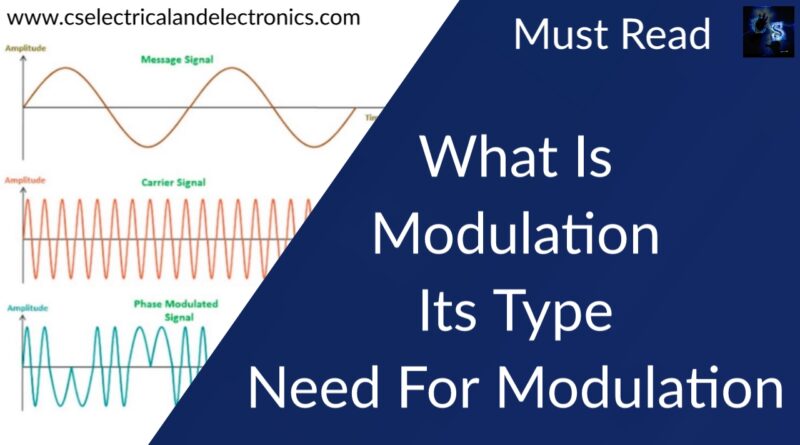What Is Modulation, Demodulation, Types, Need For Modulation
Hello guys, welcome back to my blog. In this article, I will discuss what is modulation, what is demodulation, the need for modulation, and its types such as amplitude modulation, angle modulation, etc.
If you have any doubts related to electrical, electronics, and computer science, then ask questions. You can also catch me on Instagram – Chetan Shidling.
Also, read:
- What is Process Scheduling in Operating System, Types Of Process Scheduling.
- What Is Electric Drive, Working, Applications, Advantages, Disadvantages.
- What Is SCADA, Why SCADA Is Needed, Advantages, Disadvantages.
What Is Modulation
The basic purpose of radio communication is concerned with the transmission and reception of information (message). Modulation is the process of altering some characteristic of a high-frequency carrier in accordance with the instantaneous values of a baseband voice, video, or digital signal. Thus, the information to be sent is impressed upon the carrier.
The information signal is called the modulation signal. The term unmodulated carrier refers to an empty RF carrier whose characteristics have not been altered. It is a carrier that is containing no information. The process of modulation_converts the unmodulated carrier into a modulated carrier. The modulated carrier is a signal which is containing information.
Demodulation means recovery of the original information from the modulated signal.
Need For Modulation
01. Modulation for long-distance communication:
There are many instances when the baseband signals are incompatible with the media. For example, voice signals cannot be transmitted directly by radio. To transmit baseband signals by radio, modulation_techniques must be used. Long-distance communications can be achieved by radio.
02. Modulation for ease of radiation:
Antennas are needed to radiate and receive signals in wireless communication systems. Efficient electromagnetic radiation requires antennas whose dimensions are multiples of lambda/2 where lambda is the wavelength of the signal being radiated. Many baseband signals have frequency components down to 100 Hz or lower. For these signals, antennas of 300 km length will be necessary if the signal is radiated directly. If modulation is used on a high-frequency carrier, say at 300 MHz, the antennas need not be more than half a meter long.
03. Modulation for multiplexing:
If a number of signals utilize a single channel, modulation may be used to translate different signals to different frequency bands. Multiplexing is the process of transmitting a number of signals simultaneously using a single communications channel without interference. Applications of multiplexing include data telemetry, FM stereophonic broadcasting, computer communications, cable television, long-distance telephone, etc.
04. Modulation for frequency assignment:
Modulation_allows several radio or television stations to broadcast simultaneously at different carrier frequencies and allows different receivers to be “tuned” to select different stations. Different communication services have been allocated to different segments of the frequency spectrum. For example, mobile communications take place at frequencies that are different from that of radio or TV broadcast. FM radio is allocated a frequency band that does not interfere with AM radio.
05. Modulation to reduce noise and interference:
The effect of noise and interference cannot be completely eliminated in a direct communication system. However, it is possible to minimize their effects by using certain types of modulation_schemes. For example, frequency modulation is immune to noise and interference.
06. Modulation to overcome equipment limitations:
The performance and complexity of signal processing devices such as filters and amplifiers depend on the signal frequency. Modulation_can be used for translating the signal to a frequency where design requirements are easily met. Modulation can also be used to convert a “wideband signal” ( a signal for which the ratio of highest to the lowest signal frequencies is large) to a “narrowband” signal. In signal processing applications the frequency range of the signal and the processing equipment may not match. In such cases, processing equipment is made to operate in a fixed frequency range and the frequency range of the signal is translated accordingly. Modulation_can be used to accomplish this frequency translation.
Types Of Modulation
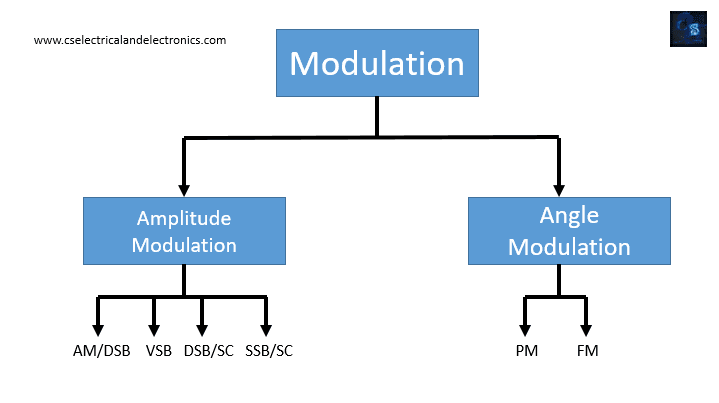
In continuous wave, modulation_systems carrier is usually a sine wave of higher frequency than that of intelligence signal. The information or intelligence signal is also called the modulating signal. Three basic characteristics of the carrier can be changed by the information signal, namely, amplitude, frequency, and phase. Frequency and phase modulations are collectively called angle modulation. Accordingly, there are two widely used families of analog continuous-wave modulation_systems:
01. Amplitude modulation
02. Angle modulation
01. Amplitude Modulation
Amplitude_modulation (AM) may be further classified as follows:
a. AM with both sidebands and carrier (AM/DSB)
b. Vestigial Sideband (VSB)
c. Double side-band suppressed carrier (DSB/SC)
d. Single side-band suppressed carrier (SSB/SC)
e. Independent side-band suppressed carrier (ISB/SC)
AM/DSB is very popular for radio broadcast and radiotelephony. For TV transmission with a large bandwidth, VSB is preferred because of reduced bandwidth. DSB/SC or SSB/SC provides a further reduction in power and bandwidth requirements. SSB/SC finds extensive use in the multiplexed coaxial systems and can carry several messages simultaneously. All AM systems are prone to noise which directly affects the signal amplitude.
02. Angle Modulation
Angle_modulation may be further subdivided as follows:
a. Frequency_modulation (FM)
b. Phase_modulation (PM)
Now, I will discuss what is amplitude modulation, frequency modulation, and phase modulation.
Amplitude Modulation
Amplitude_modulation is a process in which the amplitude of the RF carrier signal is altered in accordance with the instantaneous values of the modulating signal while keeping the frequency and phase constant. The process of amplitude_modulation is shown below.
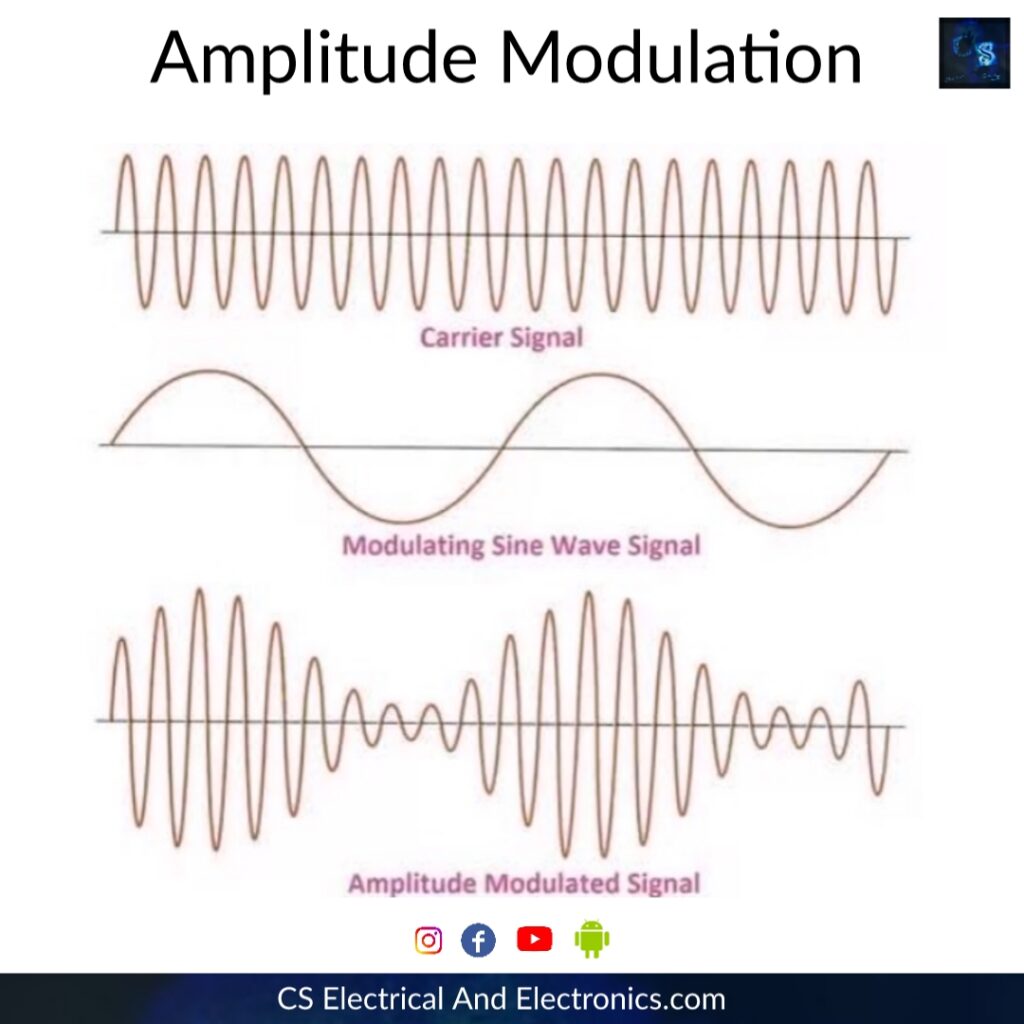
Frequency Modulation
Frequency_modulation is a process in which the frequency of the carrier signal is made to vary in accordance with the instantaneous values of modulating signal while the amplitude of the carrier is held constant. The process of frequency modulation is shown below. When the modulating signal is zero, the output frequency equals fc (center frequency). When the modulating signal reaches its positive peak, the frequency of the modulated signal reaches maximum. At negative peaks of the modulating signal, the frequency of the FM wave reaches a minimum. Thus, the processor frequency_modulation makes the frequency of the carrier deviate from its center frequency (fc) by an amount frequency deviation.
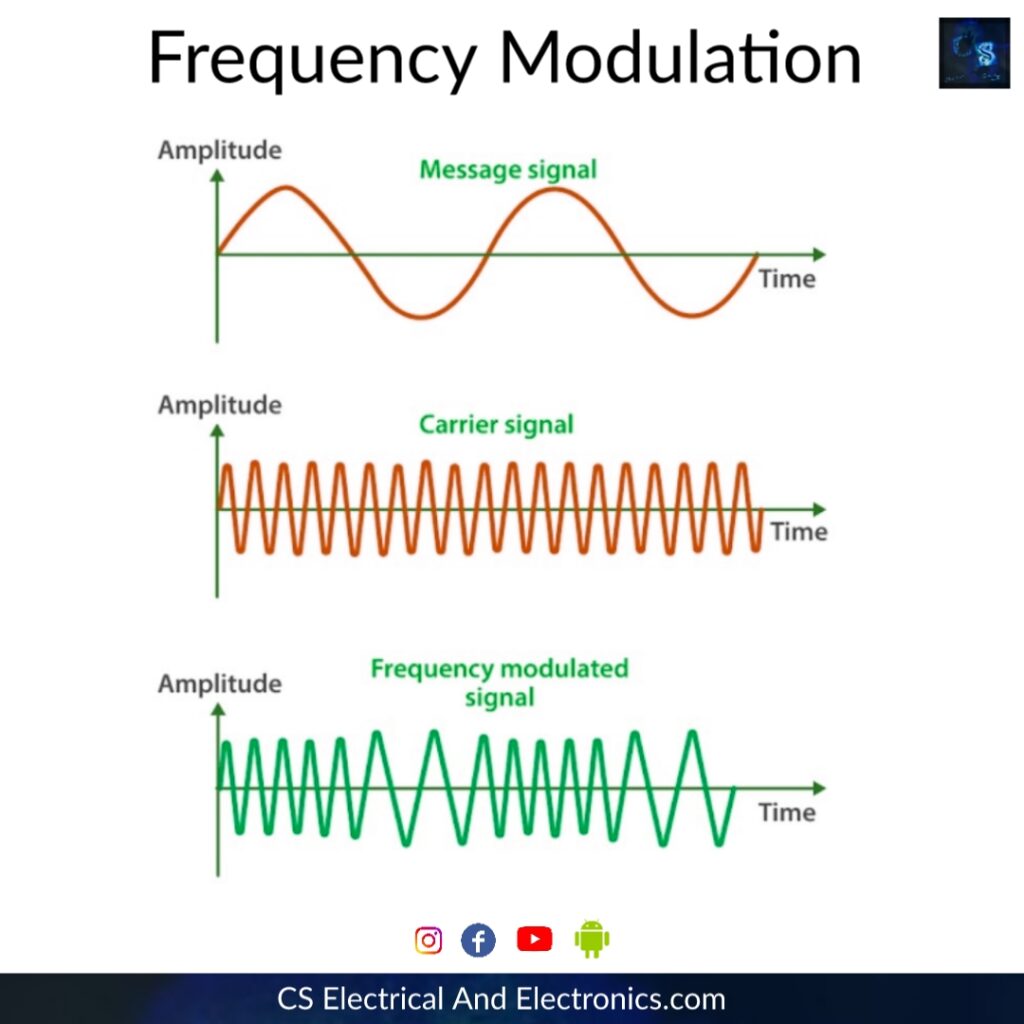
Phase Modulation
Phase_modulation (PM) is a process in which the amount of phase shift of a carrier is varied in accordance with the amplitude and rate of change of modulating signal. PM produces frequency modulation because variation in phase shift amounts to frequency change. Higher modulating produces greater phase shift which in turn produces greater frequency deviation. Higher modulating frequencies produce a faster rate of change of the modulating voltage and also produce a greater frequency deviation. Thus, the carrier frequency deviation is proportional to both modulating amplitude and frequency. During the constant amplitude positive and negative peaks no frequency change takes place. Maximum frequency deviation is produced corresponding to zero-crossing points of the modulating signal.
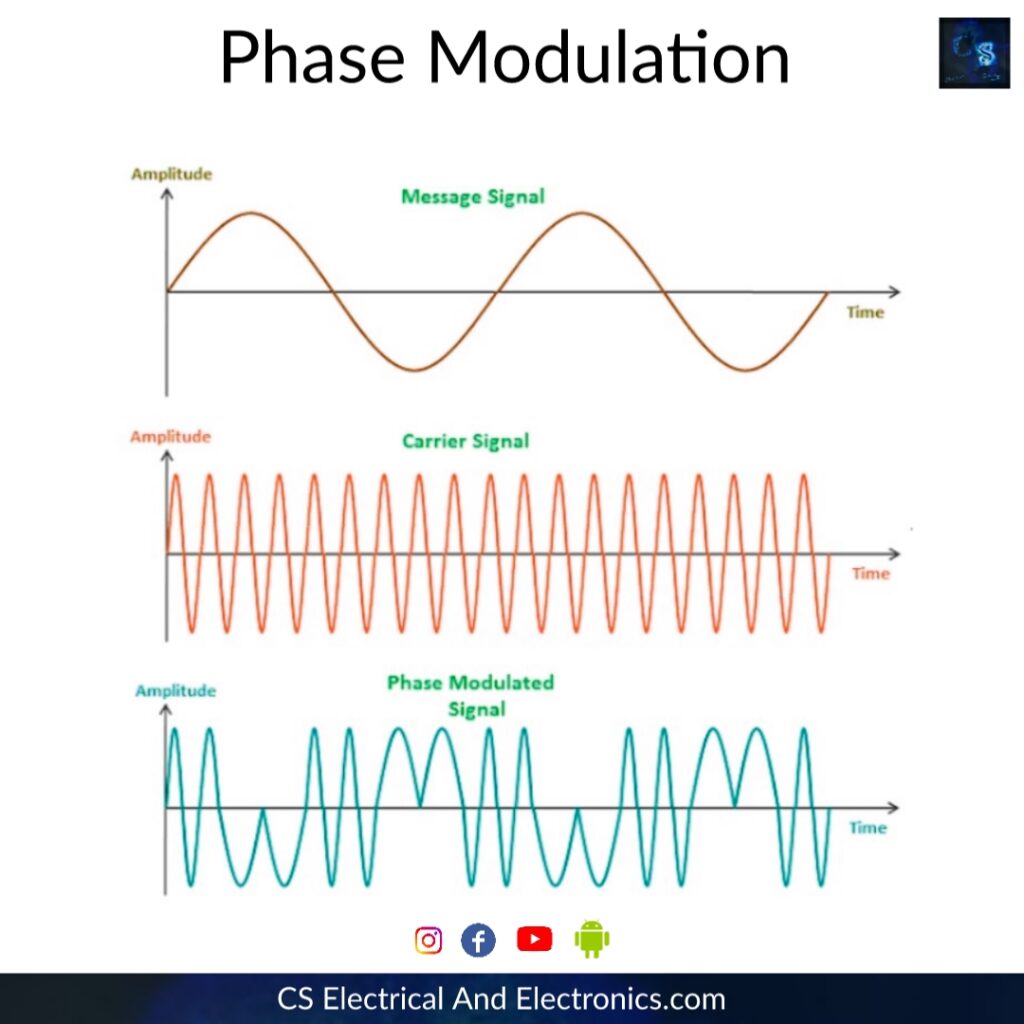
I hope this article may help you all a lot. Thank you for reading.
Also, read:
- 100 + Electrical Engineering Projects For Students, Engineers
- 1000+ Electronics Projects For Engineers, Diploma, MTech Students
- 1000+ MATLAB Simulink Projects For MTech, Engineering Students
- 500+ Embedded System Projects For Engineer, Diploma, MTech, PhD
- 500+ Projects For Diploma Electrical, Electronics Student, Diploma Project
- 8051 Microcontroller Timers, TCON Register, TMOD Register
- Advancements In 3D Printing Technology And It’s Future
- Advancements In Power Electronics For Energy Efficiency
Author Profile
- Chetu
- Interest's ~ Engineering | Entrepreneurship | Politics | History | Travelling | Content Writing | Technology | Cooking
Latest entries
 All PostsApril 29, 2024Top 11 Free Courses On Battery For Engineers With Documents
All PostsApril 29, 2024Top 11 Free Courses On Battery For Engineers With Documents All PostsApril 19, 2024What Is Vector CANoe Tool, Why It Is Used In The Automotive Industry
All PostsApril 19, 2024What Is Vector CANoe Tool, Why It Is Used In The Automotive Industry All PostsApril 13, 2024What Is TCM, Transmission Control Module, Working, Purpose,
All PostsApril 13, 2024What Is TCM, Transmission Control Module, Working, Purpose, All PostsApril 12, 2024Top 100 HiL hardware in loop Interview Questions With Answers For Engineers
All PostsApril 12, 2024Top 100 HiL hardware in loop Interview Questions With Answers For Engineers

